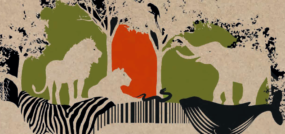Event Details
Posted on 19 Jun 2017
Presentation of Tuesday Reitano, Deputy Director, to the UNHCR Annual Consultations with NGOs 2017 on Wednesday 14 June 2017 at the UNHCR headquarters in Geneva.
The Global Initiative was glad to have the opportunity to participate in a panel discussion on protection in mixed migration flows, at the annual UNHCR Consultations with NGOs, as part of the dialogue around the Global Compact on Refugees. The presentation, is below.
The Role of Smugglers in Protection for People on the Move
Before the summer of 2015, few would have anticipated that what began as the secondary movement of Syrian refugees in Turkey towards Europe, would be swamped by citizens of a myriad of other nationalities. 885,000 people crossed the Aegean sea in 2016; 1.1 million if you measure from the summer of 2015 to summer of 2016; of which in total only 44% were Syrian. They were followed by nationals of Afghanistan and Iraq, but also Bangladesh and Pakistan, Eritrea and Sudan.
Today, through the Libyan gateway, which has pushed between 140,000 to 180,000 people onto the Mediterranean in the last three years, the top nationalities of those transiting has fluctuated significantly. Nigerians have always held high, but if you look at the 2017 statistics, it is Bangladeshis who are the second most prominent, representing nearly 12% of the flow. Nationalities whose claims to international protection certainly requires individual analysis.
The contemporary migration picture is now incredibly complicated. Human smugglers have become a vector in irregular migration, that shapes who moves, how they move, where they go. Theirs is a business model designed around economies of scale, and thus they consistently amplify the number of people moving, recruiting new migrants along any route that is proven successful.
In many contexts, smugglers are responsible for grievous violations of human rights and the heedless loss of life. Since 2014, and at an accelerating rate, the Mediterranean has been the world’s deadliest border crossing. This year alone more than 1850 people have been estimated dead or missing, due in the largest part to smugglers sending migrants to sea in overstuffed, unseaworthy vessels.
Those that arrive safely in Europe arrive terrified, traumatised, reporting stories of heinous abuse along their journeys: 72% of migrants reported physical violence, in a recent IOM survey; others speak of forced labour, sexual exploitation and rape, involuntary detention for indefinite periods, but also of kidnapping and extortion.
This dynamic has made it almost impossible for those receiving them to distinguish in any meaningful way between refugees and migrants. A migrant who may have begun his or her journey for economic reasons, whilst traversing a country such as Sudan and Yemen, for example, may experience conditions of harshness equivalent to any warzone, or in escaping a smuggler to whom they owe money or allegiance, may consider themselves to have grounds for asylum.
This doesn’t then even begin to account for the choreographed efforts of professional smugglers to exploit the asylum system for the benefit of their clients. Advice given around nationality swapping, procuring false passports and identification documents, preparing stories for immigration officers to enhance the likelihood that they are seen as warranting international protection.

I make this latter point because I want to emphasise one issue here. In the absence of regular migration pathways, smugglers are service providers for those on the move: both refugees and migrants. And while the international narrative, particularly in the current climate, prefers to emphasise the criminality and abusiveness of smugglers, in fact in many cases, and most pertinently in the case of refugees, smugglers are a crucial lifeline to help people who are vulnerable to move when there are barriers or obstacles preventing them from doing so. In all cases, smugglers offer an important service to communities where they assist in the achievement of generational investments. In many contexts, it is a source of resilience. This is why their services are in such high demand. The profiteers of human misery are actually profiteers of human aspirations.
Ethnographic studies and global experience show that, for a number of reasons, smugglers are in profile far more like the migrants that they serve, and that the industry is not inherently violent. In fact, it has a number of inherent safeguards built into it, which protect the migrant and refugees, build the reputation of the smuggler allowing him to command repeat business. Every smuggler we have interviewed has willingly shared their endorsements from satisfied clients.
Smuggling is an industry that is highly responsive to its environment. The space for the smuggling industry to thrive comes directly from the policies of states of source, transit and desired destination. Where situations are difficult to exit, where borders are difficult to cross, the demand for smugglers is increased, and the balance of power between clients and smuggler shifts. Where a migrant or refugee is afforded few, or no, safe or legal options for movement, and where demand for movement is particularly high as in a refugee context – then the power of the smuggler is high. The prices he can charge and the care he is required to take of the migrant is low.

The securitisation of borders and efforts to prevent mobility therefore perversely empower, strengthen and enrich smugglers, and increase the chances that smuggling becomes predatory. This triggers a vicious policy cycle that is visible in Africa now, or along the US-Mexico border:
- Smuggling becomes so exploitative and abusive that it becomes described as ‘trafficking’.
- Traffickers are used as a justification to impose harsher border controls and policies to prevent migrants using smugglers. Ostensibly for their protection.
- With demand remaining high, the smuggling industry ratchets up the scale of criminality, with only the most professional, corruption actors left to enable the increased levels of demand.
- Empowered criminal and violent groups present in a country (or along its borders) become an inherent threat justification for a further targeting by state security.
These cases, which are arguably not human trafficking as they continue to remain broadly consensual journeys, and often with migrants undertaking them cognisant of the risks of violence and preparing accordingly: in the Horn of Africa, for example, female migrants have reported that they knew the likelihood of rape was high, so they took contraceptives; others have said that they and their families factor the costs of kidnapping for ransom and extortion into their return on investment calculations before making the journey.
These cases significantly undermine the capacity of both the systems of international protection and asylum to respond, and erode their utility:
- When screening suggests 90% of migrants may be victims of human trafficking, and there are 180,000 people under consideration, how is it possible to ensure that the proper response: “to protect, prevent and prosecute” can be delivered.
- Similarly, how can the asylum system respond to those who fled their homes, as their numbers are swelled by more than double by those whose protection needs are acquired en route?
Arguably, new responses are needed:
- Those which dial back the risks for those seeking movement and mobility for resilience or aspirational purposes, so that they are not pushed into a framework where their needs trigger international protection mechanisms.
- Responses which do enable and empower smugglers at the expense of their clients, but rebuild safeguards into their systems of movement.
We would also argue, importantly, that understanding the dynamics of the smuggling market offers important opportunities for those concerned with the management of mixed migration, and is an imperative for those concerned with protection.
Studying the smuggling market as a driver and dynamic of migration, rather than understanding it and responding to it purely as a crime would allow the anticipation and dispersal of large scale movements, allowing a greater degree of preparedness for the countries of transit and receipt; and perhaps preventive interventions that would better protect those on the move, whether refugees or migrants.
Photo by Priscilla Du Preez on Unsplash



